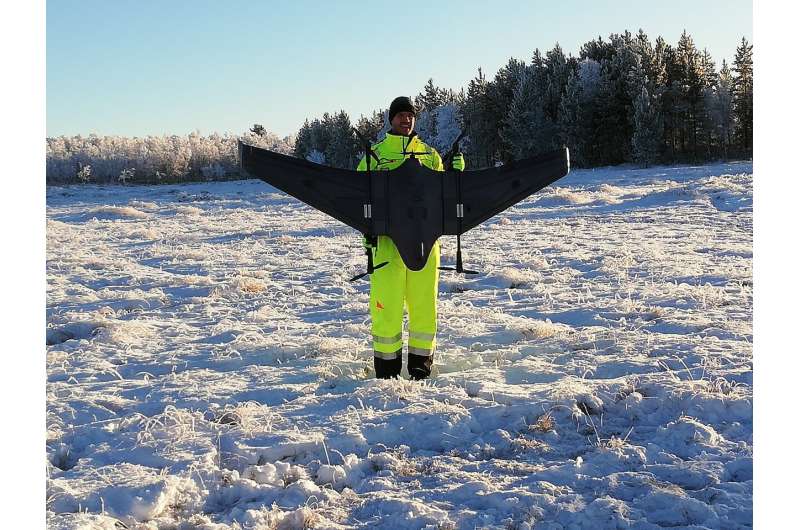One of Aviant's founders, Lars Erik Fagernæs, calibrates the drone sensors before a test flight. Credit: Norwegian University of Science and Technology (NTNU)
The distance between the Norwegian towns of Røros and Trondheim is about 100 kilometers as the crow flies. Three entrepreneurs from the Norwegian University of Science and Technology (NTNU)want to use drones to transport medical samples between them.
Røros Hospital is a branch of St. Olavs Hospital in Trondheim. The hospital takes medical samples all the time, but these often have to be analyzed in Trondheim.
Today, the transport of these medical samples takes place largely by car. But this is a 150 kilometer stretch by road, and especially in winter the idea of another option is appealing for the transporters.
Entrepreneurs Herman Øie Kolden, Bernhard Paus Græsdal and Lars Erik Fagernæs are working on a solution.
"We're building something that can make a difference, and that can hopefully save lives and contribute to society. It's really rewarding and motivating," says Fagernæs.
The three entrepreneurs are nerds in the best sense of the word. They're civil engineers with a somewhat greater than average interest in drones, and together they have complementary specialist expertise in physics, mathematics, cybernetics, robotics and computer science. They are a match that wasn't created in heaven, but at NTNU.
Test flight completed
In 2019, the three master's students completed a study year abroad at prestigious MIT in the US, with some of the most talented drone lecturers in the world. That experience sparked their idea to develop delivery drones.
They started the company Aviant. Not long afterwards, Aviant secured an agreement with St. Olavs hospital to develop a solution for sending biological samples between the two hospitals.
"We use pre-built drones but replace most of the electronics with solutions we've developed," says Fagernæs.
A test flight between the cities has already been completed. Using 4G, the drone flew a total of 120 kilometers at 120 meters above the ground. A drone can carry medical samples in half the time that a car requires—and can help save lives.
Strong confidence in the solution
Currently, an operator on the ground needs to follow the delivery drone on a screen during transport.
"But in the future, the idea is that this operator would be able to follow several drones at the same time. Then you save working hours in addition to delivery time," Fagernæs says.
Numerous entities have expressed confidence in the solution. Innovation Norway has given them NOK 1.5 million (~EUR 147000) in grant funding. The Research Council has contributed NOK 1 million (~EUR 98000) in support of the start-up.
Other companies are thinking along the same lines. Fagernæs hopes they will be able to create a Norwegian collaboration and develop solutions that can compete with foreign actors.
Provided by Norwegian University of Science and Technology (NTNU)
























